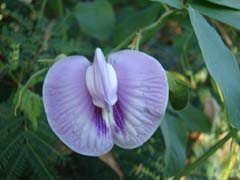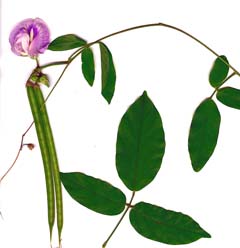 |
|
Forest Starr & Kim Starr www.starrenvironmental.com |
 |
| Forest Starr & Kim Starr www.starrenvironmental.com |
Translate this page:
Summary
Physical Characteristics

 Centrosema pubescens is an evergreen Perennial Climber growing to 0.5 m (1ft 8in) by 0.5 m (1ft 8in) at a fast rate.
Centrosema pubescens is an evergreen Perennial Climber growing to 0.5 m (1ft 8in) by 0.5 m (1ft 8in) at a fast rate.
See above for USDA hardiness. It is hardy to UK zone 10.
It can fix Nitrogen.
Suitable for: light (sandy), medium (loamy) and heavy (clay) soils and can grow in nutritionally poor soil. Suitable pH: mildly acid, neutral and basic (mildly alkaline) soils. It can grow in full shade (deep woodland) semi-shade (light woodland) or no shade. It prefers moist or wet soil and can tolerate drought.
UK Hardiness Map
US Hardiness Map
Synonyms
Centrosema molle Mart. ex Benth.
Plant Habitats
Edible Uses
References More on Edible Uses
Medicinal Uses
Plants For A Future can not take any responsibility for any adverse effects from the use of plants. Always seek advice from a professional before using a plant medicinally.
None known
References More on Medicinal Uses
The Bookshop: Edible Plant Books
Our Latest books on Perennial Plants For Food Forests and Permaculture Gardens in paperback or digital formats.

Edible Tropical Plants
Food Forest Plants for Hotter Conditions: 250+ Plants For Tropical Food Forests & Permaculture Gardens.
More

Edible Temperate Plants
Plants for Your Food Forest: 500 Plants for Temperate Food Forests & Permaculture Gardens.
More

More Books
PFAF have eight books available in paperback and digital formats. Browse the shop for more information.
Shop Now
Other Uses
Fodder
Agroforestry Uses: The plant is grown as a green manure in some parts of the tropics[46 ]. Centro has been used as a green manure and plantation ground cover in Java and Peninsular Malaysia since the 19th century[310 ]. It is widely used as a plantation cover and/or pasture legume in South-East Asia, the Pacific Islands, the wet tropics of Australia and indeed much of the humid tropics worldwide[310 ] It is an efficient fixer of nitrogen, with concentrations generally ranging from 2.4 - 2.7%[310].
Special Uses
Carbon Farming
References More on Other Uses
Cultivation details
Agroforestry Services: Nitrogen Agroforestry Services: Understory legume Fodder: Pasture Management: Fodder Minor Global Crop
A plant of the moister tropics. It prefers an annual rainfall of 1,500 mm or more but plants have persisted in pastures receiving an average annual rainfall of only 800 mm[310 ]. It can survive a 3 - 4 month dry season but is not adapted to prolonged drought[310 ]. It is intolerant of low temperatures, growing poorly when they fall below 15?c[310 ]. Tolerant of waterlogged conditions[310 ]. Plants are shade tolerant, and can persist even with shade levels as high as 80%[310 ]. The plant produces large quantities of viable seeds. It has escaped from cultivation and become established in the wild in some areas[305 ]. It forms dense mats of growth on the ground, and also climbs onto trees. It is a vigorous plant that invades disturbed areas, choking out more desirable species - often the tree layer is destroyed and regeneration of native species is prevented[305 ]. Centro is notoriously slow to establish and requires good conditions during the establishment period, but when grown in a pure sward it forms a dense, compact cover 35 - 45 cm deep, 4 - 8 months after sowing. It is fully established and vigorous by at least the 2nd year. In ungrazed mixtures with Panicum maximum, it forms an impenetrable vine canopy some 2 metres high. In a mixture with calopo (Calopogonium mucunoides) and puero (Pueraria phaseoloides), centro persists longest under the closing canopy of plantation crops[310 ]. In the humid tropics, the preferred legumes for fertile and infertile soils have traditionally been centro and stylo (Stylosanthes guianensis) respectively. However, when soil mineral deficiencies are corrected and seed is inoculated with an effective bacteria, centro has been more productive than stylo on all land classes[310 ]. Centro combines well with other species in mixed pastures or ground covers under plantation crops[310 ]. Trailing runners have a tendency to root at the nodes if soil moisture is high, giving the plant a stoloniferous appearance[310 , 415 ]. Pure stands of centro have produced DM yields of up to 12 tonnes per hectare per year[310 ]. This species has a symbiotic relationship with certain soil bacteria, these bacteria form nodules on the roots and fix atmospheric nitrogen. Some of this nitrogen is utilized by the growing plant but some can also be used by other plants growing nearby[200 ]. Nodulation occurs with a range of rhizobia but optimal growth has been achieved with very few strains. Inoculation with an effective strain of Bradyrhizobium is, therefore, recommended[310 ]. Estimates of nitrogen fixation range from 120 - 270 kg/ha per year[310 ].
Carbon Farming
-
Agroforestry Services: Nitrogen
Plants that contribute to nitrogen fixation include the legume family – Fabaceae.
-
Agroforestry Services: Understory legume
Legume vegetation, especially the trees and shrubs growing between the forest canopy and the forest floor.
-
Fodder: Pasture
Enclosed tracts of farmland mainly of grasses, with an interspersion of legumes and other forbs (non-grass herbaceous plants).
-
Management: Fodder
Non-destructive management systems maintaining the soil organic carbon.
-
Minor Global Crop
These crops are already grown or traded around the world, but on a smaller scale than the global perennial staple and industrial crops, The annual value of a minor global crop is under $1 billion US. Examples include shea, carob, Brazil nuts and fibers such as ramie and sisal.
References Carbon Farming Information and Carbon Sequestration Information
Temperature Converter
Type a value in the Celsius field to convert the value to Fahrenheit:
Fahrenheit:
The PFAF Bookshop
Plants For A Future have a number of books available in paperback and digital form. Book titles include Edible Plants, Edible Perennials, Edible Trees,Edible Shrubs, Woodland Gardening, and Temperate Food Forest Plants. Our new book is Food Forest Plants For Hotter Conditions (Tropical and Sub-Tropical).
Shop Now
Plant Propagation
Up to 60% of the seed has a hard coat and will germinate better if some form of scarification is used. On a domestic scale this is most easily carried out by immersing the seed in a small quantity of very hot water for a few minutes and then leaving the seed in warm water for 12 - 24 hours before sowing. Other methods include chipping a small part of the seed case near the embryo, being very careful not to damage the seed, or, on a commercial scale, a short immersion in sulphuric acid[310 , K ]. Seeding rate is about 5 kg/ha. Full seed-bed preparation and careful crop planting procedures are generally recommended, especially since centro is somewhat slow to establish. However, centro has been successfully sod-seeded directly into a run-down grass pasture, following heavy grazing and low slashing of the residual grass[310 ].
Other Names
If available other names are mentioned here
Native Range
NORTHERN AMERICA: Mexico (San Luis Potosí, Campeche, Chiapas, Ciudad de México, Colima, Guerrero, Hidalgo, Jalisco, México, Michoacán de Ocampo, Morelos, Nayarit, Oaxaca, Puebla, Querétaro, Quintana Roo, Tabasco, Veracruz de Ignacio de la Llave, Yucatán) SOUTHERN AMERICA: Costa Rica, Guatemala, Honduras, Nicaragua, Panama (west), El Salvador, Colombia
Weed Potential
Right plant wrong place. We are currently updating this section.
Please note that a plant may be invasive in one area but may not in your area so it's worth checking.
A vigorous plant that invades disturbed areas, choking out more desirable species - often the tree layer is destroyed and regeneration of native species is prevented[305 ].
Conservation Status
IUCN Red List of Threatened Plants Status : This taxon has not yet been assessed

Growth: S = slow M = medium F = fast. Soil: L = light (sandy) M = medium H = heavy (clay). pH: A = acid N = neutral B = basic (alkaline). Shade: F = full shade S = semi-shade N = no shade. Moisture: D = dry M = Moist We = wet Wa = water.
Now available:
Food Forest Plants for Mediterranean Conditions
350+ Perennial Plants For Mediterranean and Drier Food Forests and Permaculture Gardens.
[Paperback and eBook]
This is the third in Plants For A Future's series of plant guides for food forests tailored to
specific climate zones. Following volumes on temperate and tropical ecosystems, this book focuses
on species suited to Mediterranean conditions—regions with hot, dry summers and cool, wet winters,
often facing the added challenge of climate change.
Read More
Expert comment
Author
Benth.
Botanical References
Links / References
For a list of references used on this page please go here
A special thanks to Ken Fern for some of the information used on this page.
Readers comment
| Add a comment |
|
If you have important information about this plant that may help other users please add a comment or link below. Only comments or links that are felt to be directly relevant to a plant will be included. If you think a comment/link or information contained on this page is inaccurate or misleading we would welcome your feedback at [email protected]. If you have questions about a plant please use the Forum on this website as we do not have the resources to answer questions ourselves.
* Please note: the comments by website users are not necessarily those held by PFAF and may give misleading or inaccurate information.
To leave a comment please Register or login here All comments need to be approved so will not appear immediately.
|
Subject : Centrosema pubescens
|
|
|
|